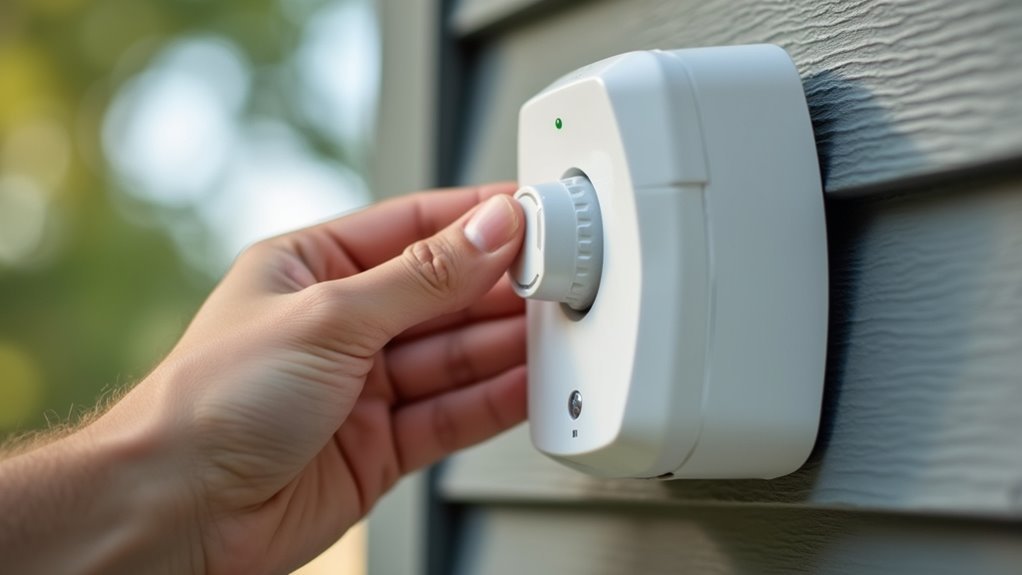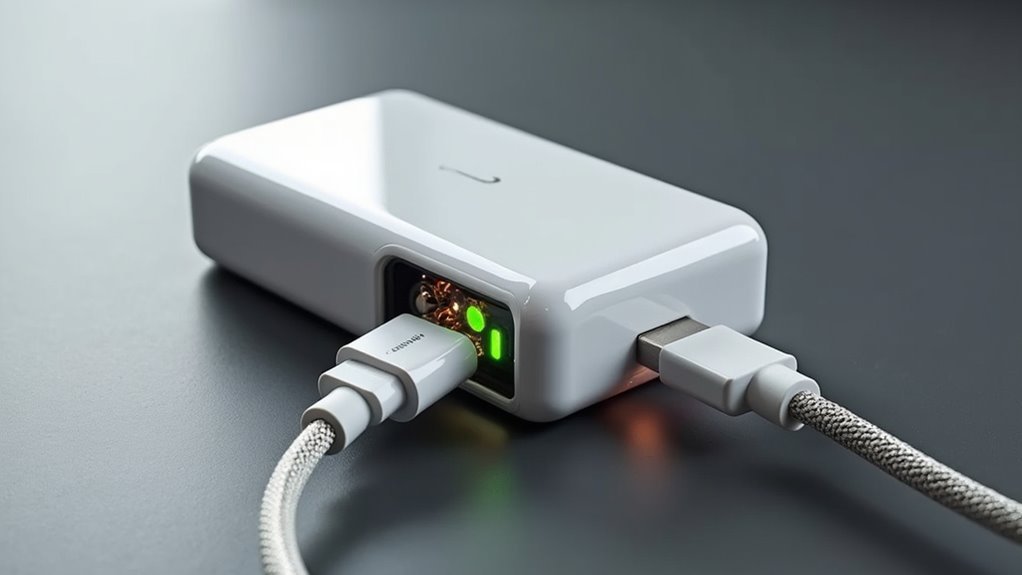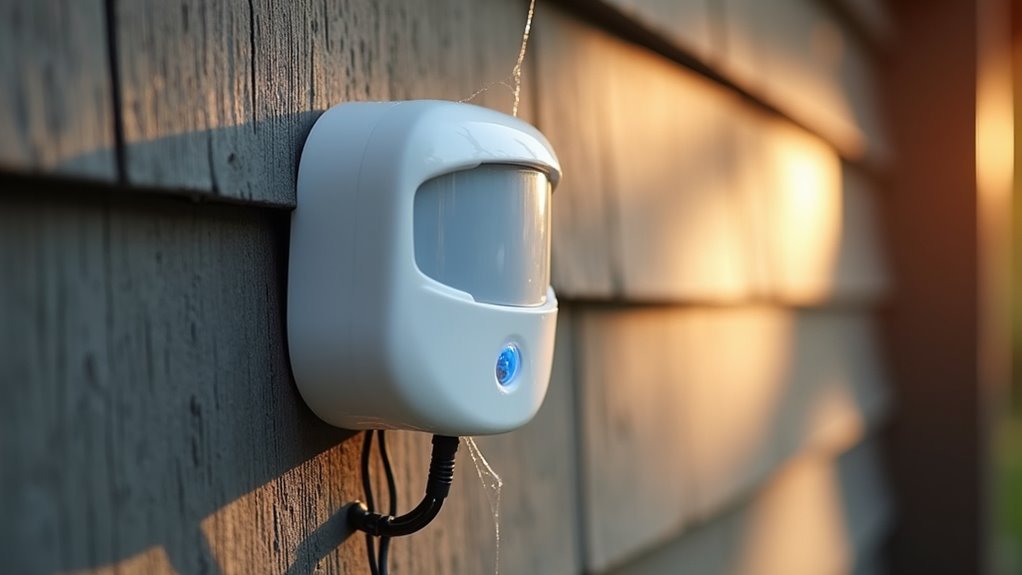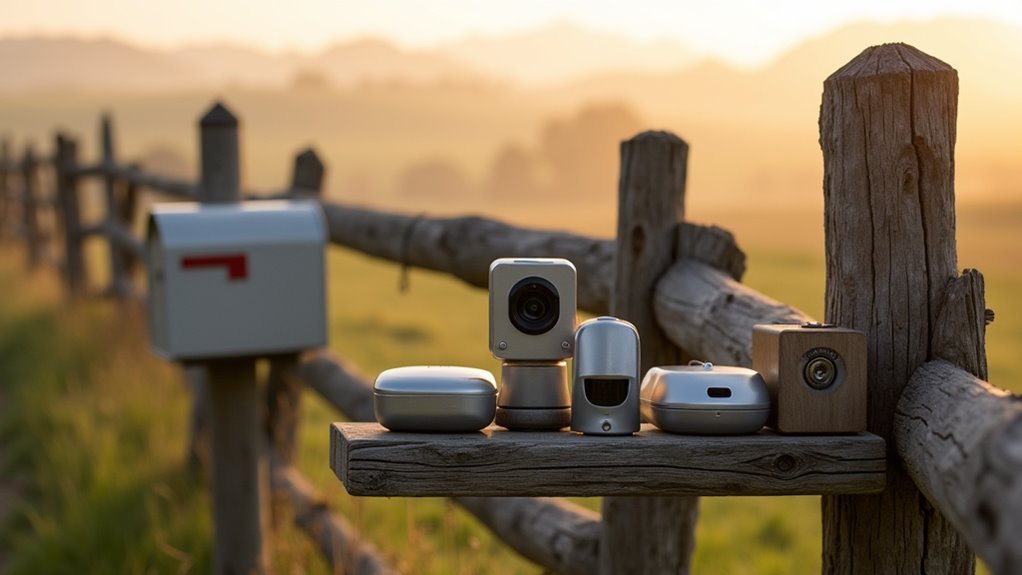You’ve probably noticed your motion sensors eating through batteries faster than expected, leaving you constantly replacing them or dealing with dead devices at the worst possible moments. The frustrating cycle of frequent battery changes doesn’t have to be your reality, and you don’t need expensive upgrades to solve this problem. Simple adjustments to placement, sensitivity settings, and power management can dramatically extend battery life while maintaining the security and convenience you depend on.
Understanding Motion Sensor Power Consumption Patterns

Anyone looking to maximize their motion sensor’s battery life must first understand when and how these devices consume power. Your motion sensor light doesn’t drain energy continuously – it primarily consumes power during activation periods.
Each time the sensor detects movement, it triggers the light for a predetermined duration, creating drain spikes rather than constant consumption.
The frequency of these activations directly impacts your battery’s longevity. High-traffic areas naturally result in more frequent triggers, accelerating power consumption and reducing battery life.
Additionally, your brightness settings considerably influence energy usage – higher levels create substantial drain during each activation cycle.
To extend the battery life effectively, you’ll need to monitor these consumption patterns. Understanding when your sensor activates most frequently helps you optimize settings and placement for maximum efficiency.
Optimal Placement Strategies for Reduced Battery Drain
While you can’t control foot traffic patterns, you can strategically position your motion sensor lights to minimize unnecessary activations and preserve battery power. These ideal placement strategies will greatly reduce battery drain over time.
First, avoid high-traffic areas where constant movement triggers frequent activations. Keep lights away from trees or moving branches that cause false triggers throughout the day.
Strategic placement away from high-traffic zones and moving vegetation prevents unnecessary activations that rapidly drain your motion sensor’s battery life.
Install your sensors at 5-7 feet height for enhanced detection while preventing activation from small animals or passing vehicles. Use adjustable sensitivity settings to fine-tune activation thresholds, ensuring only notable movement triggers the lights.
Position sensors in darker areas where ambient light naturally reduces daytime activations. This strategic approach extends battery longevity while maintaining effective security coverage around your property.
Adjusting Sensitivity Settings to Minimize False Triggers

You’ll greatly extend your motion sensor’s battery life by fine-tuning its sensitivity settings to prevent unnecessary activations from small animals, wind-blown objects, or distant vehicle movement.
Finding the ideal sensitivity level requires testing different settings until your sensor responds only to human-sized movements within your desired detection area.
Optimal Sensitivity Levels
Since motion sensors can drain batteries rapidly through false triggers, adjusting sensitivity settings becomes one of the most effective ways to extend your device’s lifespan.
You’ll want to find the sweet spot where your motion sensors detect genuine security threats while ignoring minor movements like swaying branches or small animals.
Start by setting sensitivity to medium levels, then gradually adjust based on your specific environment. If you’re experiencing frequent false triggers, lower the sensitivity until activations become more purposeful.
However, don’t set it so low that it misses legitimate movement.
Test different settings during various weather conditions and times of day. This approach helps you optimize battery life while maintaining effective security coverage.
Motion Detection Zones
Beyond adjusting overall sensitivity, configuring specific motion detection zones gives you precise control over where your sensor responds to movement. This targeted approach helps extend battery life by eliminating unnecessary activations from areas you don’t need monitored.
Setting up precise detection zones offers several advantages:
- Block pet areas – Configure zones to exclude spaces where pets frequently move, preventing constant false triggers.
- Avoid street traffic – Set boundaries that don’t include sidewalks or roads where passing cars and pedestrians create unwanted activations.
- Exclude vegetation – Remove tree branches and bushes from detection areas to prevent wind-induced movement from draining your battery.
- Focus on entry points – Concentrate motion detection on doorways and specific pathways where you actually need security coverage.
This strategic zoning approach markedly reduces battery drain while maintaining effective security coverage.
Choosing Energy-Efficient LED Technology Options
You’ll dramatically extend your motion sensor’s battery life by switching from traditional incandescent bulbs to energy-efficient LED technology.
LEDs consume considerably less power while delivering the same brightness levels—high-quality options like Lepotec can produce up to 25 lumens with minimal energy draw.
This power consumption optimization can stretch your battery life from weeks to 3-12 months, depending on your usage patterns.
LED Vs Traditional Bulbs
When selecting bulbs for your motion sensor lights, LED technology dramatically outperforms traditional incandescent options in every measure that matters for battery life.
You’ll immediately notice the difference in energy consumption and performance.
Here’s why LEDs deliver superior long-lasting battery performance:
- Energy Efficiency: LEDs consume 80% less electricity than incandescent bulbs while producing identical brightness levels.
- Extended Lifespan: You’ll replace LEDs after 25,000 hours compared to traditional bulbs’ mere 1,000-hour lifespan.
- Reduced Heat Generation: LEDs minimize energy waste through heat production, maximizing battery effectiveness.
- Adjustable Brightness: Many LED motion sensors offer brightness controls, letting you conserve power when full illumination isn’t needed.
Investing in high-quality LED technology from reputable brands guarantees peak light output and energy efficiency for your motion sensor applications.
Power Consumption Optimization
Since you’ve already made the smart choice to use LED technology, maximizing power consumption becomes your next vital step for extending battery life.
You’ll want to invest in dimmable LED options that allow brightness adjustments according to your specific needs, reducing overall energy draw when full illumination isn’t necessary.
Choose motion sensor lights with advanced LED circuitry that activates only when movement’s detected, preventing unnecessary power drain.
High-quality batteries paired with energy-efficient LEDs create an ideal combination for extended operation.
Regular maintenance of your LED fixtures is important for power consumption maximization – clean lenses and housings make certain your lights don’t work harder than needed, which would drain batteries faster and reduce overall system efficiency.
Proper Charging Techniques for Rechargeable Devices

Although many users overlook charging habits, proper techniques can greatly extend your motion sensor’s battery lifespan. USB rechargeable devices require specific care to maintain the battery’s best performance over time.
Follow these essential charging practices:
- Unplug when fully charged – Avoid overcharging by disconnecting your device once it reaches 100%, as prolonged charging degrades battery performance.
- Use compatible chargers – Always use chargers with correct voltage and amperage to prevent damage and maximize efficiency.
- Keep ports clean – Regularly remove dust and debris from charging connections to improve performance.
- Charge in ideal conditions – Choose cool, dry locations for charging, as extreme temperatures negatively affect battery life and capabilities.
Temperature Impact on Battery Performance and Longevity
Beyond proper charging habits, environmental conditions play a major role in your motion sensor’s battery performance.
Temperature impact greatly affects how long your batteries last and function effectively. Extreme cold below 32°F accelerates battery depletion, while excessive heat damages battery chemistry and causes overheating.
Temperature extremes below 32°F or excessive heat significantly reduce battery life and damage the internal chemistry of motion sensors.
You’ll get best performance when temperatures stay between 32°F and 95°F, especially with lithium-ion batteries commonly found in rechargeable motion sensors.
To maintain the battery’s health, position your devices away from areas experiencing temperature extremes like direct sunlight, heating vents, or unprotected outdoor locations during harsh weather.
Regularly check your motion sensor’s placement and consider relocating devices exposed to temperature fluctuations.
This simple step prevents premature battery failure and guarantees consistent, reliable illumination when you need it most.
Smart Scheduling to Conserve Power During Low-Activity Periods
When you’re not using certain areas regularly, smart scheduling becomes your most effective tool for extending motion sensor battery life. By setting specific active hours, you’ll prevent unnecessary power consumption during quiet periods when lights aren’t needed.
Modern motion sensor lights offer programmable features that help extend battery life considerably:
- Customizable on/off schedules that limit activations during low-traffic hours
- Automatic seasonal adjustments based on changing activity patterns throughout the year
- Smart home system integration for occupancy-based power conservation strategies
- Time-of-day automation that optimizes energy use when lights are most essential
Smart scheduling can increase your battery lifespan by 20-50% depending on usage patterns.
You’ll find that fewer activations mean less frequent recharging, making this strategy essential for maintaining efficient energy use.
Network Connectivity Optimization for Zigbee Devices
You can greatly extend your Zigbee motion sensor’s battery life by optimizing your network’s connectivity.
Start by strengthening your mesh network coverage through strategic placement of line-powered devices, which creates more reliable communication paths and reduces the energy your sensors need for transmissions.
Additionally, you’ll want to reduce how often you query your devices for status updates, since frequent polling drains batteries faster than necessary.
Strengthen Mesh Network Coverage
Since Zigbee devices rely on mesh networking to communicate, strengthening your network’s coverage directly impacts how efficiently your motion sensors consume battery power.
A robust mesh network reduces the energy your devices need to transmit signals, ultimately extending battery life.
To enhance your mesh network coverage:
- Add line-powered devices as repeaters – Smart switches, outlets, and hardwired sensors strengthen signal paths and reduce communication strain on battery-powered devices.
- Position devices strategically – Place repeaters between your hub and motion sensors to eliminate dead zones and minimize signal hops.
- Integrate additional Zigbee devices – More connected devices create redundant pathways, improving overall network reliability.
- Monitor signal strength regularly – Check device placement to guarantee ideal connectivity and prevent excessive power consumption from weak signals.
Reduce Device Query Frequency
Beyond optimizing your mesh network’s physical structure, adjusting how frequently your hub communicates with motion sensors represents another powerful strategy for extending battery life.
Each time your hub queries a device, it forces the sensor to wake up and consume precious energy responding to these requests.
You can reduce device query frequency through your smart home platform’s settings, typically found in device management or advanced configuration menus. Instead of checking battery status daily, extend intervals to weekly or monthly.
Disable unnecessary status reports and limit polling to essential functions only.
This approach dramatically reduces the number of wake-up cycles your motion sensors experience, directly translating to months of additional battery longevity while maintaining reliable motion detection performance.
Environmental Factors That Affect Battery Life
While motion sensors offer convenient hands-free lighting, several environmental conditions can dramatically impact how long your batteries last. Understanding these factors helps you enhance placement and settings for maximum efficiency.
Key environmental elements affecting battery performance include:
- Temperature extremes – Cold weather causes rapid battery depletion, while heat can damage internal components and reduce overall lifespan.
- High humidity levels – Moisture creates corrosion on battery contacts and circuitry, leading to poor connections and premature failure.
- Frequent false triggers – Moving branches, animals, or weather conditions activate sensors unnecessarily, draining your battery more quickly than normal usage patterns.
- Brightness demands – Higher illumination settings consume more power, so choose devices with low energy consumption LEDs like Lepotec’s technology for superior performance.
Regular Maintenance Practices for Extended Battery Health
Although environmental factors play an essential role in battery performance, proper maintenance practices can markedly extend your motion sensor’s battery life and guarantee reliable operation.
Regular maintenance starts with cleaning your device’s lens and body to prevent dirt buildup that interferes with performance and drains power unnecessarily. You’ll also want to check and tighten all connections periodically, confirming proper functionality while preventing power drain from loose components.
Protecting your sensors from extreme temperatures prevents rapid battery depletion and maintains peak performance. Remember to turn off motion sensor lights when they’re not needed, conserving precious battery power.
Most importantly, follow your manufacturer’s specific charging and maintenance guidelines to enhance battery health and ensure your motion sensors operate reliably throughout their entire lifespan.
Red Light Mode Benefits for Nighttime Applications
When you switch to red light mode on your motion sensor, you’ll preserve your natural night vision while considerably reducing battery drain.
Red light requires less power than white light settings, which means fewer activations and longer intervals between battery changes.
You’ll also maintain better visibility in dark environments without the harsh glare that disrupts your eyes’ adaptation to low-light conditions.
Night Vision Preservation
Since your eyes naturally adapt to darkness over a 20-30 minute period, preserving this night vision becomes essential for effective nighttime activities with your motion sensor device.
Red light maintains this adaptation while helping extend battery life through reduced energy consumption.
When you use red light mode, you’ll experience these key advantages:
- Zero glare disruption – Red illumination won’t reset your natural night adaptation process
- Clear dark visibility – You’ll maintain ideal vision without compromising your eyes’ sensitivity
- Reduced wildlife disturbance – Animals remain undisturbed during observation activities
- Enhanced task performance – Reading maps and performing detailed work becomes easier without blinding nearby companions
Your motion sensor device’s red light functionality provides the perfect balance between maintaining natural night vision and conserving precious battery power during extended outdoor adventures.
Extended Battery Performance
Red light mode delivers exceptional battery performance by consuming up to 70% less power than standard white light settings on your motion sensor device.
You’ll notice dramatically longer operational times when your rechargeable Motion Sensor operates in red light mode, as it requires considerably less energy to maintain adequate brightness levels. This extended battery performance translates to fewer charging cycles and reduced maintenance needs for your device.
The lower energy consumption stems from red light’s minimal power requirements compared to bright white illumination.
You can expect weeks of additional runtime during nighttime applications, making red mode ideal for areas requiring consistent monitoring without frequent battery replacements.
This efficiency proves particularly valuable for outdoor installations where accessing charging ports becomes challenging during harsh weather conditions.
Solar Panel Integration for Continuous Power Supply
While traditional motion sensor lights drain batteries relatively quickly, you’ll find that solar panel integration transforms them into self-sustaining power systems.
Solar panels harness sunlight during daylight hours, continuously charging your device’s battery and considerably reducing dependence on stored power alone. This setup allows you to extend battery life appreciably while maintaining consistent nighttime operation.
Solar integration creates a self-sustaining power cycle that keeps your motion sensor lights charged and operational around the clock.
Here’s how solar integration benefits your motion sensor lights:
- Daytime recharging guarantees batteries stay topped off without manual intervention
- Reduced environmental impact eliminates frequent disposable battery replacements
- Easy installation with modern systems designed for seamless compatibility
- Optimal performance in sunny outdoor locations where motion sensors are most needed
You’ll enjoy reliable illumination without the hassle of constant battery monitoring or replacement.
Monitoring Battery Status Without Excessive Power Drain
Although checking battery levels seems essential, you’ll actually drain your motion sensor’s power faster if you monitor it too frequently. Instead of constantly querying battery status, establish baseline performance patterns by observing your device’s usage over time. This approach reduces unnecessary energy consumption while maintaining awareness of your sensor’s health.
Set up smart automations that notify you only when battery levels drop below specific thresholds. This targeted monitoring conserves power compared to continuous checking.
Additionally, strengthen your mesh network to improve device connectivity—better signal strength means your sensors use less energy for status updates.
Finally, regularly assess device placement to guarantee ideal positioning, as poorly located sensors consume more power when transmitting battery status information.
Upgrading to High-Capacity Battery Solutions
Beyond optimizing monitoring practices, you can dramatically extend your motion sensor’s operational life by switching to high-capacity battery solutions.
These advanced power sources deliver up to 40% more energy storage than standard AA or AAA batteries, considerably reducing recharge frequency and system downtime.
High-capacity batteries offer several compelling advantages:
- Extended operational periods – Combined with LED technology, these batteries can power your motion sensors for several months under normal usage.
- Enhanced safety features – Built-in protection against overcharging and overheating guarantees reliable, long-lasting performance.
- Improved efficiency – Advanced technology maximizes power utilization, optimizing your sensor’s energy consumption.
- Reduced maintenance – Less frequent recharging means greater convenience and fewer interruptions.
When you upgrade to high-capacity batteries, you’ll extend battery life while enhancing overall system reliability.
Frequently Asked Questions
How Do You Trick a Motion Sensor to Stay On?
You can trick a motion sensor to stay on by partially covering it with tape, placing a small weight on it, using a fan for continuous airflow, or adjusting its sensitivity settings lower.
How Long Do Motion Sensor Batteries Last?
Your motion sensor batteries typically last 3-12 months, depending on usage frequency and environmental conditions. You’ll get longer life with rechargeable batteries, quality LED technology, and ideal placement that minimizes unnecessary triggering.
How Do I Make My Motion Sensor Light Stay on Longer?
You’ll adjust your sensor’s sensitivity settings to detect only significant movement, position it strategically away from high-traffic areas, and regularly recharge batteries before they’re completely drained to maximize illumination duration.
What Is the Lifespan of a Motion Sensor?
You’ll typically get 3 to 12 months from your motion sensor’s battery life. Rechargeable options last longer, while frequent activation, battery type, and harsh environmental conditions directly impact how long yours’ll perform.





Leave a Reply